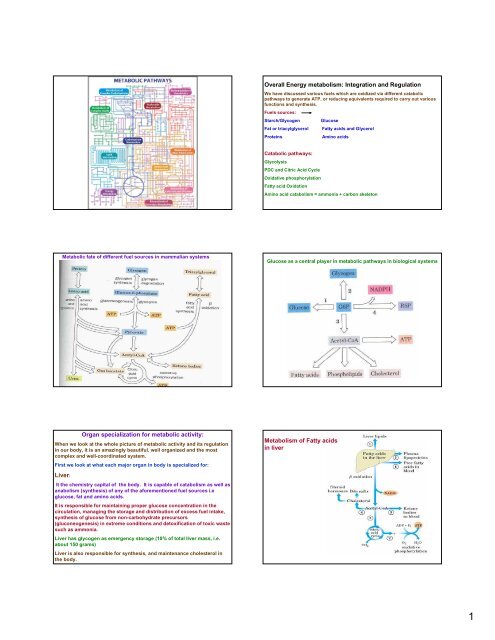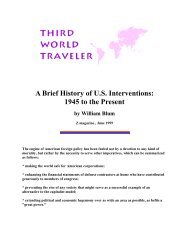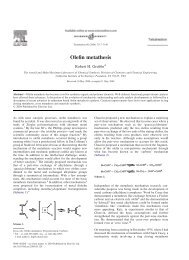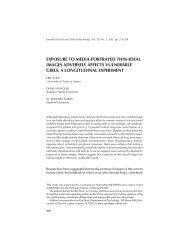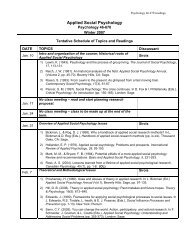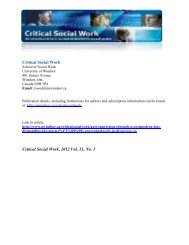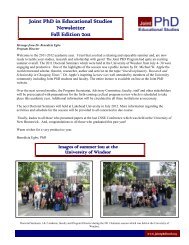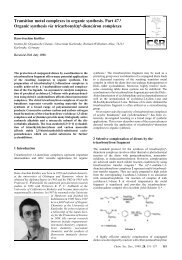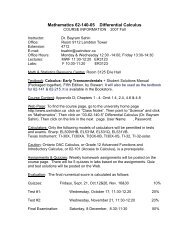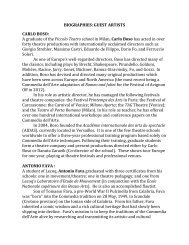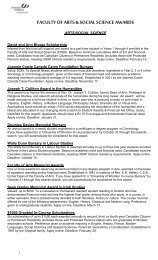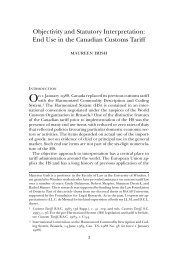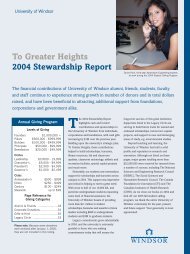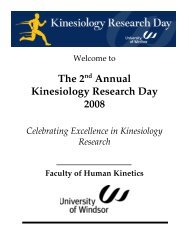Energy metabolism
Energy metabolism
Energy metabolism
Create successful ePaper yourself
Turn your PDF publications into a flip-book with our unique Google optimized e-Paper software.
Metabolic fate of different fuel sources in mammalian systems<br />
Organ specialization for metabolic activity:<br />
When we look at the whole picture of metabolic activity and its regulation<br />
in our body, it is an amazingly beautiful, well organized and the most<br />
complex and well-coordinated system.<br />
First we look at what each major organ in body is specialized for:<br />
Liver:<br />
It the chemistry capital of the body. It is capable of catabolism as well as<br />
anabolism (synthesis) of any of the aforementioned fuel sources i.e<br />
glucose, fat and amino acids.<br />
It is responsible for maintaining proper glucose concentration in the<br />
circulation, managing the storage and distribution of excess fuel intake,<br />
synthesis of glucose from non-carbohydrate precursors<br />
(gluconeogenesis) in extreme conditions and detoxification of toxic waste<br />
such as ammonia.<br />
Liver has glycogen as emergency storage (10% of total liver mass, i.e.<br />
about 150 grams)<br />
Liver is also responsible for synthesis, and maintenance cholesterol in<br />
the body.<br />
Overall <strong>Energy</strong> <strong>metabolism</strong>: Integration and Regulation<br />
We have discussed various fuels which are oxidized via different catabolic<br />
pathways to generate ATP, or reducing equivalents required to carry out various<br />
functions and synthesis.<br />
Fuels sources:<br />
Starch/Glycogen Glucose<br />
Fat or triacylglycerol Fatty acids and Glycerol<br />
Proteins Amino acids<br />
Catabolic pathways:<br />
Glycolysis<br />
PDC and Citric Acid Cycle<br />
Oxidative phosphorylation<br />
Fatty acid Oxidation<br />
Amino acid catabolism = ammonia + carbon skeleton<br />
Glucose as a central player in metabolic pathways in biological systems<br />
Metabolism of Fatty acids<br />
in liver<br />
1
Metabolism of<br />
Amino acids in liver<br />
Muscle:<br />
Major fuel for muscle are; Glycogen, glucose and Tryacylglycerol (fat)<br />
and ketone bodies. In extreme condition it can utilize amino acids.<br />
Remember the acetyl coenzyme A, and ketone bodies (both largely<br />
produced froM fat catabolism) can be utilized only in aerobic condition.<br />
Muscle is capable of anaerobic catabolism of glucose generating a quick<br />
flux of energy by glycolysis and lactic fermentation.<br />
Lactate generated by homolactic fermentation during exercise causes<br />
decrease in the pH and leads to muscle fatigue.<br />
Muscle stores Phosphocreatine as emergency energy stock.<br />
Phosphocreatine + ADP = ATP + Creatine<br />
Lactate is transported to liver via blood where it is converted to glucose<br />
through gluconeogenesis, and glucose is transported back to muscle.<br />
This inter-organic metabolic pathway is referred as Cori cycle.<br />
Heart is largely aerobic.<br />
Metabolic pathway for<br />
Glucose 6-phosphate in<br />
the Liver<br />
<strong>Energy</strong> source for<br />
skeletal muscle<br />
contraction<br />
Skeletal Muscle contain 10-<br />
30 mM phosphocreatin as<br />
emergency source of<br />
energy. Creatin kinase can<br />
rapidly produce ATP from<br />
creatin phosphate a ADP.<br />
In relaxation phase, the<br />
reaction goes in other<br />
direction making creatin<br />
phosphate using ATP.<br />
Cori cycle: glucose-lactate cycle Glucose-Alanine cycle<br />
2
The Brain<br />
Brain is very active in oxidative phosphorylation.<br />
It consumes 20% of total oxygen taken by whole body in resting stage.<br />
Remeber brain is only 2% of the total body weight. Most of the ATP<br />
generated is used by Na + /K + ATPases and other ion channels to maintain<br />
membrane potential needed for nerve impulse conduction (generation of<br />
action potential, and its transmission across the axons).<br />
Preferred fuel : Glucose. In extreme situations it can use ketone<br />
bodies.<br />
Catabolic Pathways: Glycolysis, citric acid cycle and oxidative<br />
phosphorylation.<br />
Brain has very little or no glycogen storage, it depends entirely of the<br />
blood glucose which should be maintained at around 5 mM in blood.<br />
Lower level of glucose (less than 2.5 mM causes brain dysfunction, and<br />
coma.<br />
Extended period of very low glucose (hypoglycemia) in blood may cause<br />
irreversible damage to brain or death.<br />
Adipose tissue:<br />
Adipose tissues are widely distributed throughout the body, prominently<br />
around abdominal cavity and upper part of limbs, thighs.<br />
The function of adipose tissues: Store and release fatty acids as<br />
required by the body, provide insulation for temperature, protect from<br />
physical damage and butification.<br />
These tissue obtain the fatty acids from circulation and store them as<br />
triacylglycerol.<br />
Under hormonal influence they release fatty acids into circulation to be<br />
used by other tissues.<br />
A 70 Kg person has about 15 Kg of fat, which is equivalent to 141000<br />
Calories. Thus the normal fat storage is sufficient to meet body’s energy<br />
requirement for 3 months.<br />
3
Fuel <strong>metabolism</strong> in liver<br />
during prolonged starvation<br />
4
1923; Noble Prize winners<br />
from<br />
Canada (U of T)<br />
For Insulin discovery<br />
In 1975, Dr. Saran Narang<br />
developed the synthetic<br />
primers technology that<br />
enabled the development<br />
of DNA cloning and later,<br />
DNA sequencing.<br />
Consequently, in 1982 he<br />
achieved the first total<br />
synthesis of proinsulin, an<br />
achievement for which he<br />
received the Order of<br />
Canada<br />
The Miracle of Insulin<br />
Patient J.L., December 15, 1922 February 15, 1923<br />
Nutritional calories: 1 Cal = 1 K calories = 4.1 KJ<br />
Defined as total amount of energy released during complete oxidation of the<br />
food (i.e. Carbohydrate, fat or proteins).<br />
Estimated by measuring the heat released during direct oxidation of the fuel<br />
(burning)<br />
The total free energy for complete oxidation of 1 Mole of glucose (180 gm),<br />
Glucose + 6O 2 = 6CO 2 + 6H 2 O ΔGo= -2840 kJ/mol = -686 Cal<br />
Total amount of ATP generated = 32 moles (physiological number)<br />
Total amount of free energy generated = 32 X -50 KJ = -1600 KJ = -382.77<br />
Cal<br />
The percentage of free energy stored in the form of chemical energy in ATP<br />
molecules = approximately 56%<br />
Rest is lost as heat.<br />
One gram of Carbohydrate generates approximately = 3.74 Cal = 16.7 kJoules<br />
One gram of fat ………………………………………… = 9.3 Cal<br />
These are total energy produced. Only 56% of this will be stored in ATP.<br />
5
Alcohol Toxicity:<br />
Two enzymes in liver catabolize alcohol consumed during drinking.<br />
1. Alcohol dehydrogenase: converts Ethanol to acetaldehyde using<br />
NAD + as oxidizing agent thus producing NADH<br />
CH 3 -CH 2 OH + NAD + = CH 3 CHO + NADH + H +<br />
2. Aldehyde dehydrogenase: Oxidizes acetaldehyde to acetate using<br />
NAD + , thus producing NADH.<br />
Ch 3 CHO + NAD + + H2O = CH 3 COOH + NADH + H +<br />
NADH: Inhibits 1. GAPDH 2. PDC, 3. The three dehydrogenases of CAC<br />
and β-hydroxyacylCoA dehydrogenase of β-oxidation of fatty acids.<br />
Thus, there is accumulation of fatty acids that leads to the accumulation<br />
of fat in liver leading to hyperlipidemia or fatty liver.<br />
Since CAC is inhibited, availability of oxalloacetate is also limited, this<br />
leads to the inhibition of gluconeogenesis leading to hypoglycemia.<br />
Excess of NADH accelerates lactate dh to produce lactic acid leading to<br />
Hyperlacticacidemia.<br />
Accumulation of lactic acid, and acetic acid cause acidosis in liver.<br />
Reduced adiposity in bitter melon (Momordica charantia) fed rats is associated with<br />
lower tissue triglyceride and higher plasma catecholamines.<br />
Full Papers<br />
British Journal of Nutrition. 93(5):747-754, May 2005.<br />
Chen, Qixuan; Li, Edmund T. S. *<br />
Abstract:<br />
Slower weight gain and less visceral fat had been observed when rats fed a high-fat diet were<br />
supplemented with freeze-dried bitter melon (BM) juice; the metabolic consequences and<br />
possible mechanism(s) were further explored in the present study. In a 4-week experiment,<br />
rats were fed a low-fat (70 g/kg) or a high-fat (300 g/kg) diet with or without BM (7.5 g/kg or<br />
0.75%). BM-supplemented rats had lower energy efficiency, visceral fat mass, plasma glucose<br />
and hepatic triacylglycerol, but higher serum free fatty acids and plasma catecholamines. In<br />
the second experiment, 7-week BM supplementation in high-fat diet rats led to a lowering of<br />
hepatic triacylglycerol (P < 0[middle dot]05) and steatosis score (P < 0[middle dot]05) similar<br />
to those in rats fed a low-fat diet. BM supplementation did not affect serum and hepatic<br />
cholesterol. However, plasma epinephrine and serum free fatty acid concentrations were<br />
increased (P < 0[middle dot]05). In the third experiment, BM(7.5 and 15 g/kg) and 1[middle<br />
dot]5 % BM lowered triacylglycerol concentration in red gastrocnemius and tibialis anterior (P<br />
< 0[middle dot]05) muscle, but a dose-response effect was not observed. These data suggest<br />
that chronic BM feeding leads to a general decrease in tissue fat accumulation and that such<br />
an effect is mediated in part by enhanced sympathetic activity and lipolysis. BM or its bioactive<br />
ingredient(s) could be used as a dietary adjunct in the control of body weight and blood<br />
glucose.<br />
6
In 1994, obesity gene (OB/OB)<br />
was discovered, and a defect in<br />
obese gene caused obesity in<br />
mice.<br />
This gene encodes for a protein<br />
called leptin. Leptin is produced<br />
by adipocytes.<br />
Injection of leptin in obese mice<br />
caused weight loss and loss of<br />
appetite in these mice.<br />
Thus Leptin was shown to play a<br />
major role in fat catabolism.<br />
But for human, there seem to be<br />
other complications.<br />
Structure of Human leptin<br />
as estimated by X-Ray<br />
crystallography.<br />
Leptin is a 16 kDa protein<br />
normally produced by<br />
adipocytes.<br />
In human obesity disorder,<br />
there is no deficiency of<br />
leptin production, but there<br />
might be defects with the<br />
leptin receptors in brain or<br />
problem with blood brain<br />
barrier which may limit the<br />
access of leptin to<br />
hypothalamus.<br />
In near future we expect<br />
this mechanism to be<br />
exactly elucidated and we<br />
hope that there would be a<br />
solution to obesity very<br />
soon.<br />
Amino acid sequence of Neuropeptide Y<br />
Decrease in the availability of leptin in brain leads to the secretion of<br />
neuropeptide Y from hypothalamus in brain. Neuropeptide Y<br />
stimulates appetite and promotes insulin secretion.<br />
7
POMC = Pro-opiomelanocartin<br />
MSH = Melanocyte stimulating hormone<br />
CRH = Carticotropin releasing hormone<br />
CART = Cocaine and amphetamineregulated<br />
transcript<br />
8


